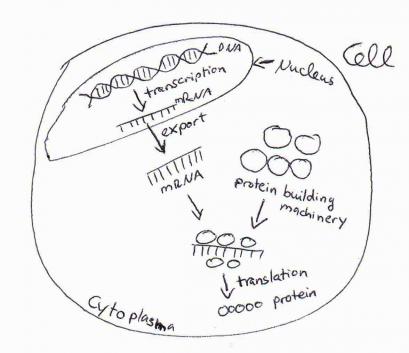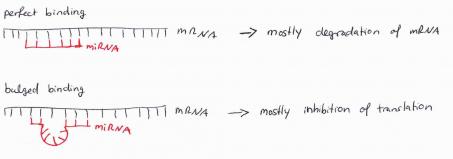Wrap your mind around microRNAs
**Part 2 of Beate Roese-Koerner's guest blog. Read Part 1 here. **
Last time I told you a lot about the cell system we use. To understand what my project is about you also need to know how a cell decides what to become and what proteins to produce. Cells make many different proteins, with a wide range of functions. The particular combination of proteins a cell makes is important for it’s identity and ability to do its job.

How does the cell know which proteins to make? The instructions are in the genes. All the cells in an individual carry the same information in their genome, but different combinations of genes are ‘turned on’ in different types of cells. To make sure that cells are able to store all information the body may need and can use it on demand, their “hard disk” - the DNA - is located in the nucleus of the cell while the protein producing machinery is located in the cell plasma (see scheme).
The information carried by the genes is transferred from the nucleus to the protein production machinery by a process called transcription. The cell copies the required information from the double-stranded DNA onto the single-stranded, less stable RNA format (so called messenger or “m”-RNA) like a blueprint. This copy is then exported from the nucleus and read by the protein producing machinery (translation).
For a long time, it was believed that the production of proteins is controlled solely by the amount of mRNA produced at a certain time point. Since mRNA is not as stable as DNA it has to be produced continuously to keep the production running.
Some years ago a second control mechanism was found. As well as mRNA, the cell can produce smaller pieces of RNA. A subgroup of these smaller RNAs is known as microRNAs (miRNAs). These miRNAs can bind to the mRNA and inhibit the production of proteins after the process of transcription. These miRNAs can bind in a perfect match to the mRNA or in a bulged formation (see scheme). Depending on the way they bind, they can inhibit protein production in different ways:

Since the miRNAs do not necessarily have to fit perfectly on the mRNA (see scheme), one miRNA can have more than one target mRNA in a cell and can influence whole sets of proteins involved in processes like the development of neurons. So miRNAs are powerful tools to give instructions to a cell.
In my next article, I will tell you some more about how we are using these tools in the laboratory.